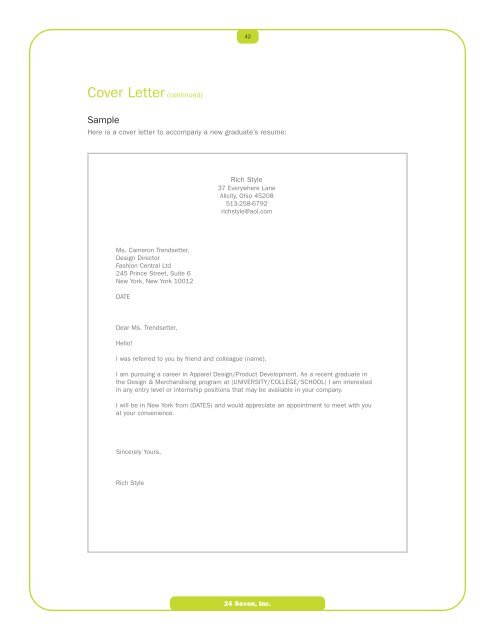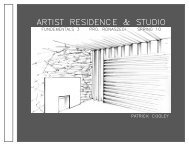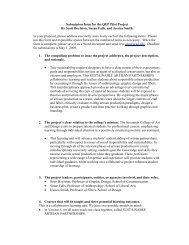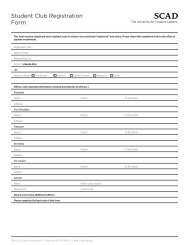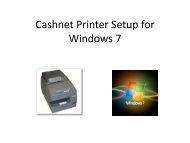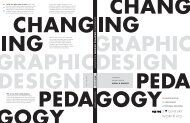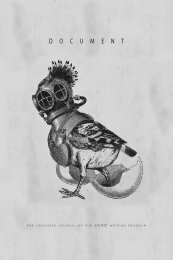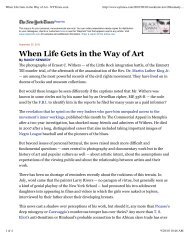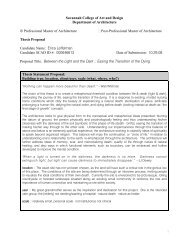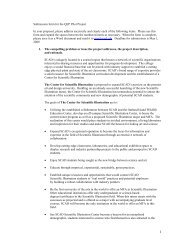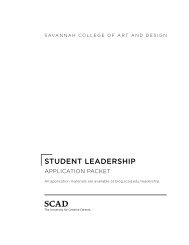How to get a job in fashion
How to get a job in fashion
How to get a job in fashion
Create successful ePaper yourself
Turn your PDF publications into a flip-book with our unique Google optimized e-Paper software.
42<br />
43<br />
Cover Letter (cont<strong>in</strong>ued)<br />
Portfolio<br />
Sample<br />
Here is a cover letter <strong>to</strong> accompany a new graduate’s resume:<br />
You weren’t expect<strong>in</strong>g a bluepr<strong>in</strong>t, right? We all know there is no magic formula for construct<strong>in</strong>g a<br />
professional, entry-level portfolio. The most you can hope for is a tried and tested approach with<br />
useful clues about what <strong>to</strong> do and what <strong>to</strong> avoid. And, that, is exactly what is here.<br />
Ms. Cameron Trendsetter,<br />
Design Direc<strong>to</strong>r<br />
Fashion Central Ltd<br />
245 Pr<strong>in</strong>ce Street, Suite 6<br />
New York, New York 10012<br />
DATE<br />
Dear Ms. Trendsetter,<br />
Hello!<br />
Rich Style<br />
37 Everywhere Lane<br />
Allcity, Ohio 45208<br />
513-258-6792<br />
richstyle@aol.com<br />
If your resume is your ticket <strong>in</strong><strong>to</strong> the <strong>in</strong>terview, your portfolio is that rabbit <strong>in</strong> the magician’s hat:<br />
tangible proof—beyond any doubt—of talent. It’s one th<strong>in</strong>g <strong>to</strong> tell people what you can do and<br />
another th<strong>in</strong>g <strong>to</strong> show them what you have done.<br />
You, and only you, can make it happen. Attention <strong>to</strong> detail could turn a textbook attempt <strong>in</strong><strong>to</strong> a<br />
masterpiece you are proud <strong>to</strong> call your own.<br />
What’s the score<br />
Types<br />
There are two dist<strong>in</strong>ct types of design portfolios: one for technical design and the other for<br />
creative design. We will discuss both separately.<br />
Size<br />
Regardless of type, your portfolio has <strong>to</strong> be a manageable size. Practicalities should figure <strong>in</strong><strong>to</strong><br />
your plann<strong>in</strong>g.<br />
Consider how much space may be available when you present. Imag<strong>in</strong>e open<strong>in</strong>g your portfolio<br />
up on a small conference table or the edge of a desk. Get the picture? Your presentation will be<br />
hampered if you can’t hold it comfortably <strong>in</strong> your hands, let alone carry it around <strong>to</strong> <strong>in</strong>terviews.<br />
Too big is just <strong>to</strong>o big.<br />
Appearance<br />
First rule: your portfolio must be clean. No smudges are acceptable. No glue should be <strong>in</strong><br />
evidence. Torn pages are simply not okay. Aim for perfection.<br />
I was referred <strong>to</strong> you by friend and colleague (name).<br />
I am pursu<strong>in</strong>g a career <strong>in</strong> Apparel Design/Product Development. As a recent graduate <strong>in</strong><br />
the Design & Merchandis<strong>in</strong>g program at (UNIVERSITY/COLLEGE/SCHOOL) I am <strong>in</strong>terested<br />
<strong>in</strong> any entry level or <strong>in</strong>ternship positions that may be available <strong>in</strong> your company.<br />
I will be <strong>in</strong> New York from (DATES) and would appreciate an appo<strong>in</strong>tment <strong>to</strong> meet with you<br />
at your convenience.<br />
S<strong>in</strong>cerely Yours,<br />
Rich Style<br />
Second rule: your portfolio must be neat. This goes for organization of thought, as well as page<br />
layout. Aim for clarity.<br />
Lowdown<br />
Your portfolio can only <strong>get</strong> you a <strong>job</strong> if you do your homework correctly. Cus<strong>to</strong>miz<strong>in</strong>g it <strong>to</strong> meet the<br />
expectations of the company you are hop<strong>in</strong>g <strong>to</strong> <strong>in</strong>terview with is the only way <strong>to</strong> go.<br />
<strong>How</strong> <strong>to</strong> assemble: for creative design<br />
Your portfolio is a very personal and <strong>in</strong>timate matter—or at least it should be! It allows a peek<br />
<strong>in</strong><strong>to</strong> how you orchestrate the creative process: from what <strong>in</strong>spires you <strong>to</strong> how you carry it through.<br />
You’re lett<strong>in</strong>g the world know how you tick and how your antenna picks up on trends. Creativity<br />
matters a lot. So does orig<strong>in</strong>ality.<br />
On approach<br />
A lot of new graduates make the mistake of present<strong>in</strong>g an avant-garde portfolio. Why is this a<br />
no-no? It won’t sell; won’t land you the <strong>job</strong>.<br />
We don’t mean <strong>to</strong> discourage you. You should and must do your own th<strong>in</strong>g, but if you are look<strong>in</strong>g<br />
<strong>to</strong> be employed, you need <strong>to</strong> gear your approach <strong>to</strong>wards what is considered commercially viable.<br />
24 Seven, Inc.<br />
24 Seven, Inc.


